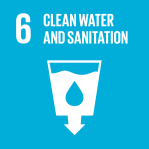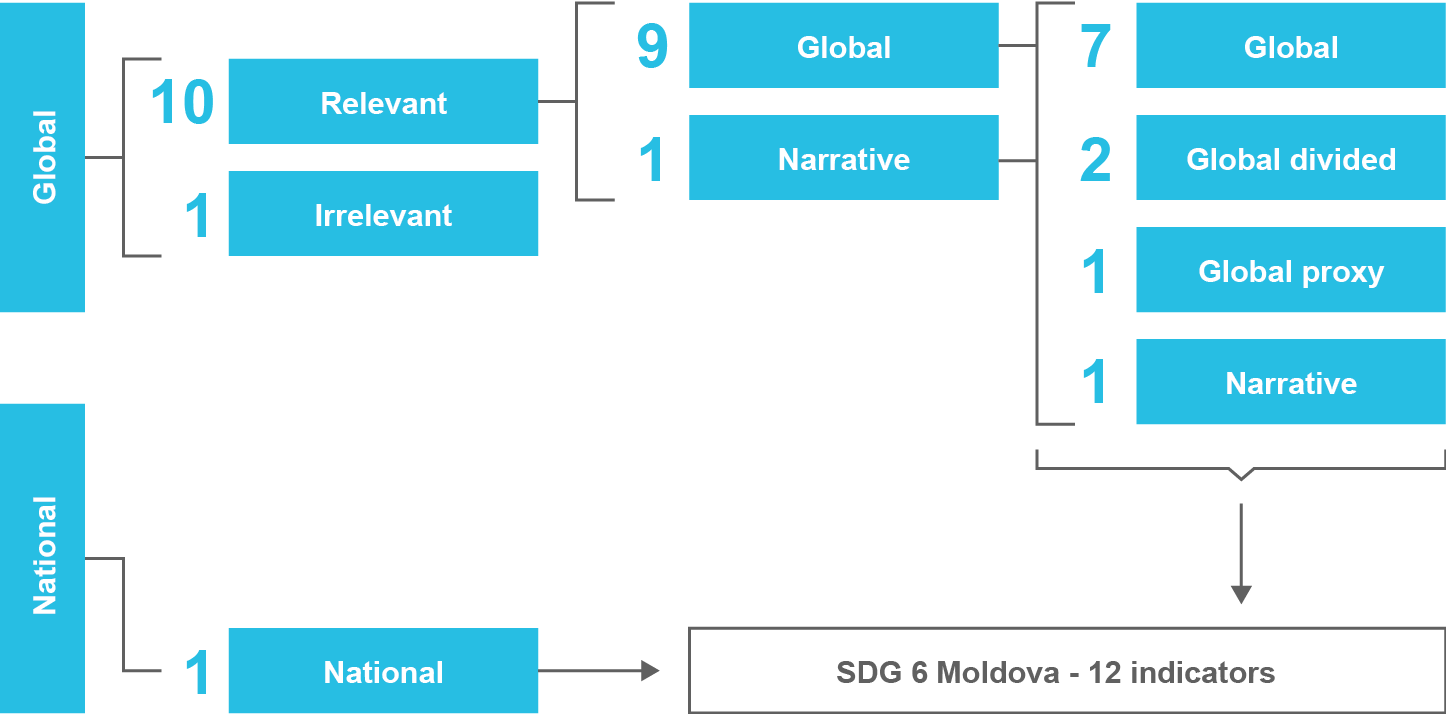Goal 6: Clean water and sanitation
The nationalized SDG 6 adopts a broad approach, as it tackles all critical aspects in the water sector. One of these includes the extended provision of safe and affordable water, and adequate and equitable sanitation for all (in particular, rural inhabitants, women and those in a vulnerable situation). The quality of water will be improved through minimization of the water pollution from industrial processes, increasing the efficiency of water use, recycling and safe reuse, and enhancement of the protection and restoring of water-related ecosystems (forests, wetlands, rivers, aquifers and lakes). Involvement of the local and regional communities in water management is of crucial importance when it comes to economic accessibility (through allocation of appropriate investment) and social justice of the rural inhabitants compared to more favoured urban dwellers. As the country’s own reserves of water are relatively small, Moldova will envisage implementing more sustainable integrated management processes in the water sector. In this regard, adequate international cooperation with the two neighbouring countries is very important. |
| Results of indicators nationalization SDG 6
|
Goal 6. Ensure availability and sustainable management of water and sanitation for all |
|
| Goal 6. Ensure availability and sustainable management of water and sanitation for all | |
GLOBAL TARGETS 2019 | GLOBAL INDICATORS 2019 |
| NATIONAL TARGETS 2017* | NATIONAL INDICATORS 2017* |
6.1 By 2030, achieve universal and equitable access to safe and affordable drinking water for all | 6.1.1 Proportion of population using safely managed drinking water services |
| 6.1 By 2023, achieve universal and equitable access to safe and affordable drinking water for 80 percent of the population and communities and, by 2030, for all. | 6.1.1 Proportion of population using safely managed drinking water services |
6.2 By 2030, achieve access to adequate and equitable sanitation and hygiene for all and end open defecation, paying special attention to the needs of women and girls and those in vulnerable situations | 6.2.1 Proportion of population using (a) safely managed sanitation services and (b) a hand-washing facility with soap and water |
| 6.2 By 2023, achieve universal access to adequate and equitable sanitation for 65 percent of population and communities and by 2030, for all, paying special attention to the needs of women and girls and those in vulnerable situations | 6.2.1 Proportion of population using safely managed sanitation services |
|
|
| | 6.2.2 Proportion of pre-primary and general education institutions with access to a centralized water supply system |
6.3 By 2030, improve water quality by reducing pollution, eliminating dumping and minimizing release of hazardous chemicals and materials, halving the proportion of untreated wastewater and substantially increasing recycling and safe reuse globally | 6.3.1 Proportion of wastewater safely treated |
| 6.3 By 2030, improve water quality by reducing pollution, eliminating dumping and minimizing release of hazardous chemicals and materials, reducing the proportion of untreated wastewater and substantially increasing recycling and safe reuse | 6.3.1 Proportion of wastewater safely treated |
| 6.3.2 Proportion of bodies of water with good ambient water quality |
| | 6.3.2 Proportion of drinkable water sources with deviations from the sanitary norms according to sanitary-chemical indicators |
|
|
| | 6.3.3 Proportion of water surface bodies according to microbiologic parameters |
6.4 By 2030, substantially increase water-use efficiency across all sectors and ensure sustainable withdrawals and supply of freshwater to address water scarcity and substantially reduce the number of people suffering from water scarcity | 6.4.1 Change in water-use efficiency over time |
| 6.4. By 2030, substantially increase water-use efficiency across all sectors and ensure sustainable withdrawals and supply of freshwater | 6.4.1. Water consumption for production needs and drinking, mil. m3 |
| 6.4.2 Level of water stress: freshwater withdrawal as a proportion of available freshwater resources |
| | 6.4.2 Proportion of water abstractions from the total water sources available |
6.5 By 2030, implement integrated water resources management at all levels, including through transboundary cooperation as appropriate | 6.5.1 Degree of integrated water resources management implementation (0–100) |
| 6.5. By 2030, implement integrated water resources management at all levels, | 6.5.1 Level of implementation of water management actions |
| 6.5.2 Proportion of transboundary basin area with an operational arrangement for water cooperation |
| | 6.5.2 Proportion of cross-border river basins areas (rivers part of international agreements) |
6.6 By 2020, protect and restore water-related ecosystems, including mountains, forests, wetlands, rivers, aquifers and lakes | 6.6.1 Change in the extent of water-related ecosystems over time |
| 6.6 By 2020, protect and restore water-related ecosystems, including forests, wetlands, rivers, aquifers and lakes | 6.6.1 Change in the extent of water-related ecosystems over time, % |
6.a By 2030, expand international cooperation and capacity-building support to developing countries in water- and sanitation-related activities and programmes, including water harvesting, desalination, water efficiency, wastewater treatment, recycling and reuse technologies | 6.a.1 Amount of water- and sanitation-related official development assistance that is part of a government-coordinated spending plan |
| Not examined | |
6.b Support and strengthen the participation of local communities in improving water and sanitation management | 6.b.1 Proportion of local administrative units with established and operational policies and procedures for participation of local communities in water and sanitation management |
| 6.b. Plan and program for a coherent and gradual development of an improved water and sanitation infrastructure for all communities based on well-defined and transparent selection criteria, including involvement of the beneficiary communities. | 6.b.1 Proportion of local administrative units with established and operational policies and procedures for participation of local communities in water and sanitation management |
Note:
* Nationalized targets, nationalized indicators and statistical data presented under this heading are taken from the Report "Nationalization of indicators for SDG" and Adapting the 2030 Agenda on Sustainable Development to the context of the Republic of Moldova elaborated by Expert-Grup in collaboration with the Government of the Republic of Moldova and UN Moldova in 2017 and presents the situation at that time. Currently, the next stage of revising the nationalized indicators is taking place, thus, some indicators can be revised or supplemented later.
 |  |  |  |  |  |  |  |  |
 |  |  |  |  |  |  |  |  |


 Goal 6: Ensure availability and sustainable management of water and sanitation for all
Goal 6: Ensure availability and sustainable management of water and sanitation for all